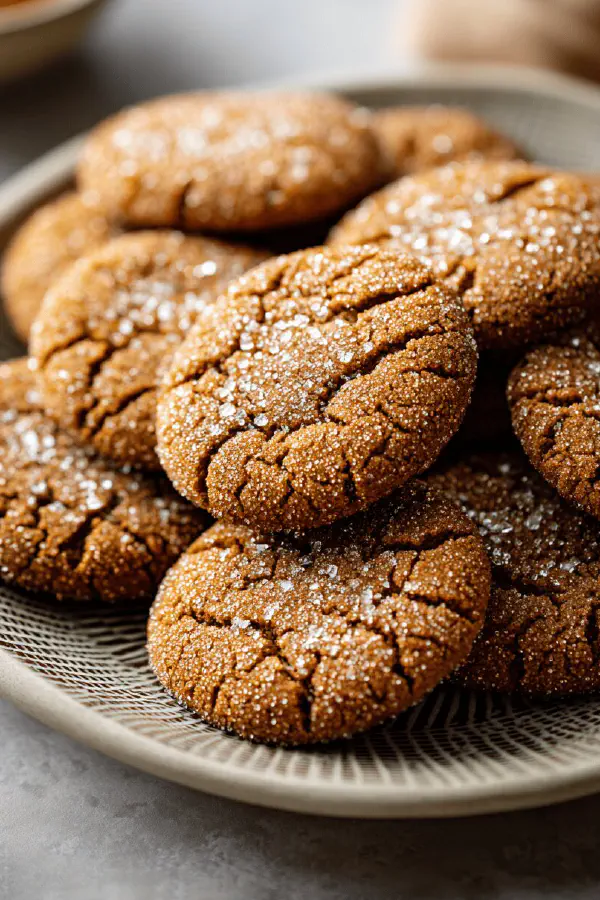Featured Recipe
Molasses Ginger Galettes

By Kate
"
Old-fashioned molasses cookies with a sharp twist of preserved ginger and a hint of cinnamon. Low nut risk, dairy-friendly (with swap), and a tender, chewy crumb. Keys are timing and texture awareness. Ingredients tweaked for a deeper spice note and better shelf life. Dough slightly smaller portions. Baking cues over clocks. Great midweek baking project. Keeps well in an airtight container for days. Swap butter for coconut oil or margarine for lactose-free. Cane sugar in place of dark brown sugar works but expect a milder flavor.
"
Prep:
18 min
Cook:
14 min
Total:
32 min
Serves:
16 galettes
cookies
baking
desserts
Introduction
Molasses and ginger go way back in baking. They punch texture and flavor, but molasses alone can overpower or dry. So altered ratios here—less flour but slightly boosted sugar, cinnamon swapped in for a touch of warmth and to cut the sharp bite of the preserved ginger. The ginger brings chew and surprise but diced small to avoid hard cookie bits. Coconut oil instead of butter offers a dairy-free fat that softens the crumb with a hint of tropical undertone — yes it affects flavor but not in a bad way. Be wary if using margarine—some contain water that can make dough too wet and cookies spread thin. Scoop smaller spheres. More but smaller cookies means better bake control and you get more accurate bites. This bakes quickly but watch edges not centers. Timing is a guideline; rely on scent and color cues. You want crackled amber edges with a moist, tender center. Cooling finishes the set-up. No rush—don’t shove them straight into containers or you risk steaming sogginess. In a pinch, ground ginger plus fresh ginger can replace preserved, but watch wetness and flavor punch. Overall, a recipe with soul and a backbone. No fluff, just tested facts from hard kitchen hours.
Ingredients
About the ingredients
Flour adjusted down by about 20 to keep cookie tender. Baking soda bumped slightly to compensate molasses acidity and give the galettes a subtle lift without blowing their shape. Salt up just a hair—primes sweet balance but not enough to taste salty. Coconut oil selected here to replace butter for lactose-intolerant bakers; choose refined if you want minimal coconut aroma, virgin for a background note of fruitiness. Dark muscovado adds richer molasses flavors compared to plain brown sugar—if unavailable use packed dark brown sugar but expect less deep molasses intensity. Preserved ginger finely diced because large bits can be aggressive chew spots and cookie structure conflicts. Cinnamon swapped in for the original ginger only to add warmth and balance the molasses edges, but could swap with cardamom or allspice for something different. Eggs provide moisture and structure; don’t skip. Molasses type matters—blackstrap yields stronger bitterness and deeper notes, regular dark molasses milder and lighter in color. Always check fat state; too melted and dough spreads too thin, too hard and mixing is tough. Mixing method matters—creaming coconut oil and sugar well keeps air and texture. Watch for sugar grain dissolution as you work.
Method
Technique Tips
Start with precise oven setting before tackling dough; preheated, steady heat avoids cooking guesswork and signaled texture contrast. Mixing dry ingredients with spices first lets you avoid pockets of bitter or salty outcomes—dissolving baking soda constantly delivered through flour means even rise. Creaming coconut oil with sugar rather than just melting and mixing keeps crumb aerated and soft; let your mixer or spatula soften fat properly. Molasses and egg are combined separately to ensure consistent moisture and acid balance. Fold dry into wet gently—overworking leads to tough cookies. Diced ginger needs folding at last stage to anchor flavor without breaking dough network. Portion control done with 35 ml scoop—not too big or small—to limit cookie spread and baking inconsistency. Space cookies 5 cm apart; they spread but not much. Bake one sheet at a time to maximize even heat exposure and watch for edge signs—firm, crackling, amber color, lightly springy center. Baking times flexible between 12-16 minutes; rely on cues not the clock. Cooling on rack (not parchment) firms bottom without sogginess; ambient air prevents residual heat steam buildup that ruins crisp edges. Store cooled galettes airtight. Leftover dough freezes well; defrost and bake with same timing cues. Common mistakes: skipping creaming stage leads to dense cookies, baking multiple sheets at once can generate uneven baking, overbaking turns chew into dry flake, underbaking yields gummy centers that tear, skipping cooling traps steam and softens edges.
Chef's Notes
- 💡 Watch dough consistency - too soft equals thin, overly melted equals spread. Cool it down if too warm. Temp, texture matter. Balance is key. Check your oil's state.
- 💡 Use dark muscovado sugar if possible. Lots of flavor. Regular brown works; milder taste. Adjust molasses type depending on bitterness preference. Blackstrap, regular.
- 💡 Diced ginger: important! Too big, hard bits. Fine chop means better texture. Not aggressive chew but flavorful punch. Consider heat from ginger in dough.
- 💡 Oven preheat necessary! Get it right. Steady heat, no guesswork. Baking sheets lined, good for even browning. Space out cookies 5 cm apart.
- 💡 Cooling stage matters. Avoid condensation. Steam ruins crisp edges. Transfer to wire rack for airflow. Let cookies set. Patience will pay off.
- 💡 Don’t skip egg! Structure and moisture provided. Important for cookie s shape and texture. No substitutes unless absolutely necessary.
Kitchen Wisdom
How to keep cookies fresh?
Airtight container works best. Prevent moisture. Can freeze dough too for quick baking future. Use wax paper in between.
What if they spread too much?
Check your fat state. Too melted is an issue. Also, ensure proper dough portion size. Maybe chill before baking.
Can I swap coconut oil?
Yes. Use margarine or butter; just keep moisture balance in mind. Overload can lead to thin cookies, adjust amounts.
Why did they come out dry?
Likely overbaked. Don’t rely solely on time; check edges. Slightly firm edges, soft centers mean done. Learn visual cues.



